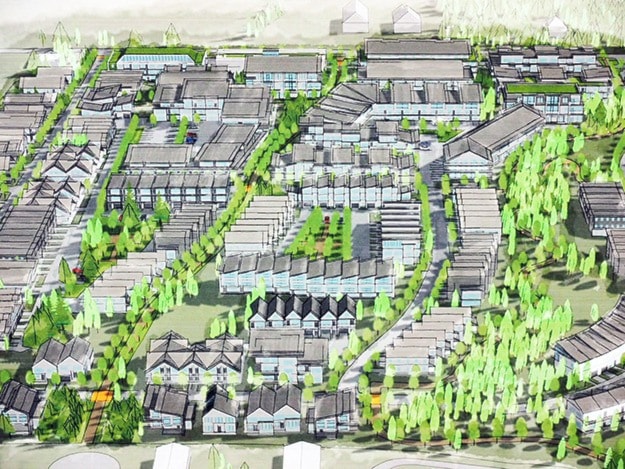The major Mackenzie Village development proposal for Arrow Heights would be a financial bonanza for the City of Revelstoke, according to reports prepared by the developer.
The development is going back to council for review after the proponents produced the series of studies that were requested of them.
David & Shelley Evans are proposing a major development with up to 1,178 units on 35 acres of land off Nichol Road in Arrow Heights.
The proposal was made public last February and was the subject of an open house in April that was attended by 154 people. After, the city asked the Evanses to produce seven reports on the project, including a traffic study, infrastructure study, environmental study, parks & trails plan, financial impact analysis, a waste disposal study, and an affordable housing strategy.
The reports were finally completed and will go in front of council for discussion on Tuesday, Jan. 26. They provide a basic overview on the impact the development would have on city infrastructure and finances.
According to the reports, which were produced by the developer, the development would provide a net financial gain to the city, particularly compared to if the property was developed as a low-density, single-family residential.
The proposed zoning would generate $7.9 million in development cost charges for the city, $1.5 million in property taxes and would create an annual net revenue of $1,170 per household compared. That's compared to $1.1 million, $238,000 and a loss of $170 per household if the property were sub-divided into single-family lots. The numbers were calculated using Community Infrastructure Planning Decision Support Tool developed by the province. The tool allows someone to input the cost of developing and providing services and infrastructure and compares it to the potential revenue that will be generated by the development.
The Review contacted Graham Inglis, the city's director of finance, to see if the numbers looked reasonable, however he said he had yet to look at the report.
Dean Strachan, the city's development manager, said that high-density, multi-family developments usually provide a net benefit to municipalities when it comes to taxation.
"Planners have known for a long time that single family development is a loss for the city as far as the tax collected," he said.
The traffic study, conducted by engineer Greg Saunders of Revelstoke Design Services, looks at the impact on the development on the major roads, including Fourth Street, Airport Way and Nichol Rod. It says the roads can handle the extra traffic that would be generated by the development, but that the Illecillewaet Bridge may require an upgrade or replacement if there's other development in the area.
The infrastructure study, by McElhanney Consulting Services, looks at roads, sewer and water. On top of indicating how the development will be serviced, it also looks at the impact it will have on city infrastructure.
Notably, it says the Greeley water treatment plant and Arrow Heights reservoir would have to be expanded before the development reaches full build. Sewage could be handled by existing city pipes, though the report makes no mention of the capacity of the sewage treatment plant.
Mike Thomas, the city's director of engineering, was not available Friday afternoon to respond to questions about the report.
Strachan said the reports were adequate for this phase, but more detailed engineering would be required for a development agreement to be reached between the Evans and the city.
"The issues that need more work before this project gets towards approval are in the traffic and the infrastructure," he said. "At this point, this is just a question of whether there's enough information for council to consider a bylaw. We're at the beginning phase and as it progresses there's going to be more information that's going to be required."
Strachan said it will now be up to council to decide how to move forward. His recommendation for Tuesday is for council to receive the report and to refer it to the Advisory Planning Commission.
"Council has to think if they need to do more public consultation in advance of a public hearing," he said. "Whether they want us to do an open house or some other type of consultation, or just proceed with the bylaw."
David Evans told the Review he was happy to see the development go back to council. He hoped that re-zoning could be completed by the end of March.
"I think the information we provided substantiates the plan," he said. "The financial benefits to the city are there. It makes sense. The footprint leaves more open space and park land."
Evans stressed the development would be for less than 1,200 units – not the 1,500 initially reported in the media – and that number could change depending on market demand. He said if people were buying smaller units, they would build more of those. If they desired larger units, they would re-focus the development that way.
"There's a whole flex part to it depending on where the demand comes from," he said.
If approved, the development would start with the construction of 30 townhouses along Nichol Road and would continue through 12 phases over 10 years.
